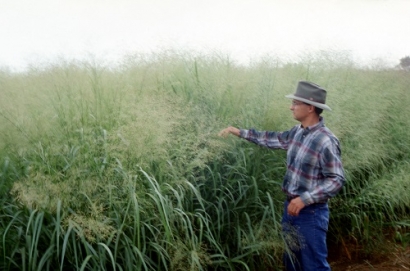
The project, backed by the U.S. Department of Energy and the Sun Grant Initiative, began in 2008 and includes researchers from 26 institutions, including the University of Illinois College of Agricultural, Consumer and Environmental Sciences. Together, they evaluated the bioenergy potential of switchgrass, Miscanthus, sorghum, energycane, and prairie mixtures in long-term trials spanning a wide geographical area. Due to shortages in plant materials, Miscanthus and energycane were grown on smaller plots than the other crops, but researchers say the new results are still valuable for producers.
“Although making real-world decisions and recommendations based on performance data from small plots is less desirable than from field-scale plots, we feel comfortable with the Miscanthus results since they were based on 33 data sets collected from five sites over seven years,” says Tom Voigt, professor in the crop sciences department at U of I and leader of the Miscanthus portion of the study.
Crops were grown for five to seven years in multiple locations and with varying levels of nitrogen fertilizer. Although most of the crops are known to tolerate poor soil quality, the researchers found that they all benefitted from at least some nitrogen. For example, Miscanthus did best with an application of 53.5 pounds per acre.
Prairie mixtures, which were grown on land enrolled in the Conservation Reserve Program (CRP), also benefitted from added nitrogen. Yield kept increasing with the addition of up to 100 pounds per acre, but the researchers pointed out, producers would have to weigh the yield benefit against the cost of the fertilizer.
“Even though it increased yield, it is economically not profitable to use more than 50 pounds of nitrogen per acres,” Voigt added.
And although most of the crops are somewhat drought-tolerant, precipitation made a difference.
“Miscanthus production was directly related to precipitation,” Voigt said. “In areas where precipitation was down, yields generally dropped. However, it did depend on timing. If there was a good amount of water in the winter, plants could get going pretty well in the spring. But if we had little rainfall after that, that hurt yields.”
Prairie mixtures, which are normally made up of hardy grasses, suffered from the severe droughts in 2012 and 2013 in some locations. “In one year in our Oklahoma location, they didn’t even try to harvest. Yield was too low,” according to D.K. Lee, associate professor in the Department of Crop Sciences at the University of Illinois and leader of the prairie mixture portion of the study.
No one feedstock “won” across the board. Instead of highlighting specific yields obtained in good years or locations, a group of statisticians within the research team used field-based yield and environmental data to create maps of yield potential for the five crops across the U.S.
According to the new results, the greatest yield potentials for lowland switchgrass varieties are in the lower Mississippi valley and the Gulf coast states, whereas Miscanthus and prairie mixture yields are likely to be greatest in the upper Midwest.
Energycane could reach very high yields, but in a relatively limited portion of the country. However, the crop that shows the highest potential yields in the greatest number of locations is sorghum. The annual crop is highly adaptable to various conditions and might be easier for farmers to work with.
Lee stated, “In terms of management, sorghum is almost the same as corn. It germinates and grows so quickly, weed control is not a big issue. If you plant by early June, it will be 15-20 feet tall by September. It also has good drought tolerance.”
Downsides to the biomass champ? It’s wet at harvest and can’t be stored. It also requires nitrogen and can lodge, or collapse, prior to harvest in wet or windy conditions. “Still, it’s a really spectacular plant,” Voigt says.
The researchers made all the raw data from the study available online for anyone to access. Lee says it can be useful for everyone: scientists, policymakers, and producers. “It should be helpful for number of different stakeholders,” he says.
The article, “Biomass production of herbaceous energy crops in the United States: Field trial results and yield potential maps from the multiyear regional feedstock partnership,” is published in a special issue of GCB Bioenergy. The project was funded through the U.S. Department of Energy [award number DE-FC36-05GO85041] and the North Central Regional Sun Grant Center at South Dakota State University.

